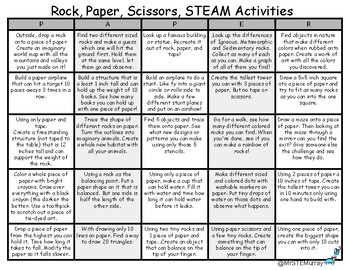Rock, Paper, Scissors...STEM! Simple activities for distance and home learning.
MrSTEMurray
270 Followers
Grade Levels
K - 6th
Subjects
Resource Type
Standards
NGSSK-2-ETS1-2
NGSSK-2-ETS1-3
NGSSMS-ESS3-2
NGSSMS-ETS1-2
NGSSK-2-ETS1-1
Formats Included
- PDF
MrSTEMurray
270 Followers
Description
Find activities to do at home can be difficult. Know what all students have to complete an activity can be varying. In this activity board you will find 25 activities that complete using only Rock, Paper, Scissors and a little bit of tape. Create a cup, make a map and many other activities. Download comes with a bonus activity. Used too much paper in these activities? Well, make your own recyclable paper! Now includes a link to google slide, make a copy to use and modify however you want!
Total Pages
Answer Key
N/A
Teaching Duration
N/A
Report this resource to TPT
Reported resources will be reviewed by our team. Report this resource to let us know if this resource violates TPT’s content guidelines.
Standards
to see state-specific standards (only available in the US).
NGSSK-2-ETS1-2
Develop a simple sketch, drawing, or physical model to illustrate how the shape of an object helps it function as needed to solve a given problem.
NGSSK-2-ETS1-3
Analyze data from tests of two objects designed to solve the same problem to compare the strengths and weaknesses of how each performs.
NGSSMS-ESS3-2
Analyze and interpret data on natural hazards to forecast future catastrophic events and inform the development of technologies to mitigate their effects. Emphasis is on how some natural hazards, such as volcanic eruptions and severe weather, are preceded by phenomena that allow for reliable predictions, but others, such as earthquakes, occur suddenly and with no notice, and thus are not yet predictable. Examples of natural hazards can be taken from interior processes (such as earthquakes and volcanic eruptions), surface processes (such as mass wasting and tsunamis), or severe weather events (such as hurricanes, tornadoes, and floods). Examples of data can include the locations, magnitudes, and frequencies of the natural hazards. Examples of technologies can be global (such as satellite systems to monitor hurricanes or forest fires) or local (such as building basements in tornado-prone regions or reservoirs to mitigate droughts).
NGSSMS-ETS1-2
Evaluate competing design solutions using a systematic process to determine how well they meet the criteria and constraints of the problem.
NGSSK-2-ETS1-1
Ask questions, make observations, and gather information about a situation people want to change to define a simple problem that can be solved through the development of a new or improved object or tool.





